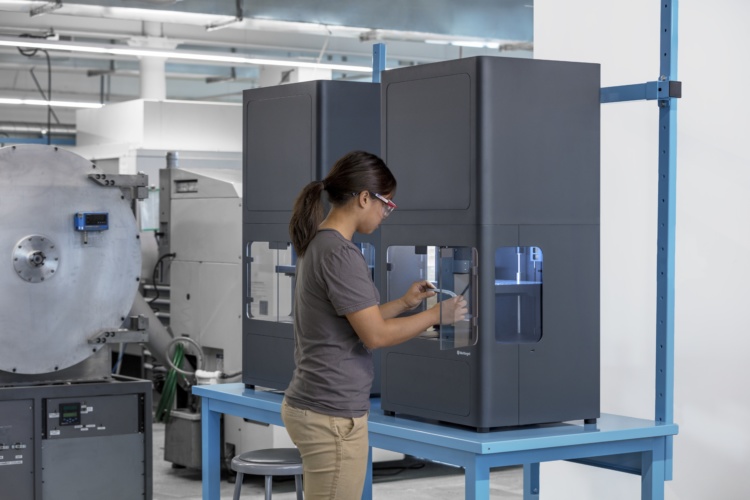As the world is cycling through lock-downs, we have all learned lessons from the first time around and developed new ways to keep businesses, supply chains and life in general moving forward. Whether it’s printing from home or garages, or half-empty factory floors, additive manufacturing has helped businesses to adapt to rapidly changing circumstances, making them more agile and robust in the face of the unexpected.
In the name of agility and keeping supply chains moving, engineers are finding they are no longer shackled to the convention of an over-simplistic “part-cost” model that previously stymied ingenuity and limited their approach when it came to additive manufacturing. Conversely, they are now freer to explore new ways of working with the technology, the overall value it can bring, problems it can solve and business risks it can mitigate. These changes in thinking were already starting to take place, but have been accelerated by the global pandemic forcing us to adopt new ways of working.
We’ve seen the creativity of the engineering community at work and heard amazing stories of innovation over the past few months, with businesses beginning to harness the full potential of their industrial grade 3D printers and use them in different and sometimes unexpected ways.

Agility in the face of a delay
For example, when faced with extended waiting times for specific medical grade raw material casting due to COVID-related delays, one orthopaedics business put this time to good use to set about streamlining their manufacturing processes with the help of their industrial 3D printers. Already using additive to print tooling jigs and fixtures, they conceived to print a ‘digital twin’ of the raw cast part they were waiting for in a composite material.
This ‘dummy part’ allowed them to perform a test run of their full manufacturing process, setting up and sequencing machines and inspection equipment in advance so it was fine-tuned and ready for the cast part as soon as it arrived. This not only saved valuable production time, but also allowed their design team to improve upon the future design of cast part. Shortening the feedback / continuous-improvement loop within the business has made the company more agile, profitable and enabled their engineers to fully express themselves. Adopting this “Design-Print” methodology has also helped to reduce and promote engineering ingenuity.
Necessity breeds invention
Delayed parts are not the only supply chain issues businesses are facing due to the pandemic. Lockdown and shutdowns in the Far East earlier this year have led to some manufacturers struggling to access some specialist materials and metal alloys. Limited supplies have led some companies to turn to additively produced alternatives to keep their production lines running, rather than being subject to delays due to disrupted supply chains.
We’ve been hearing stories from engineers taking their printers home during lockdown....adding a whole new dimension to ‘working from home’
As an example, several high-volume manufacturers using robots, cobots and other highly robotic automated handling systems hadn’t previously considered using additive as a solution – as the cost per part analysis simply didn’t add up when compared to importing the metal components. When faced with COVID-related delays and supply chain disruptions, however, the decision to invest in additive was made quickly to help keep things moving.
By printing the part with continuous carbon fibre embedded within a tough nylon/CF base matrix material, the companies were able to create parts with the same strength as the original metallic version, but at a fraction of the weight. This resulted in increased line speed and productivity. With less mass to move, the robotic arms were less stressed and line stops were reduced. Using AM also led to further design refinements from engineering teams – helping to further improve business metrics. Consequently, part-cost is no longer considered a barrier to further AM adoption within the business.

Engineers as Makers
Engineers and industrial designers are now finding themselves in the role of ‘makers’ more frequently – taking advantages of the agility additive offers to iterate new designs that previously would have been too expensive or risky to try. Echoing proven use cases printing legacy tooling or parts on site in remote areas like battlefields or disaster zones, we’ve also been hearing stories from engineers taking their printers home during lockdown to keep businesses and healthcare providers moving – adding a whole new dimension to ‘working from home’.
These examples are only a few that illustrate how engineers can do incredible things with the right tools. Fuelled by the necessity to change the way of doing business, we’ve seen so many companies looking differently at additive this year. Turning convention on its head to discover new, unexpected applications – and benefits. It is this design freedom and agility that may spell the end of the ‘part-cost’ decision making process.
Engineers, designers, and manufacturing professionals use Markforged metal and composite printers for tooling, fixtures, functional prototyping, and high-value end-use production.










Water Sector Talent Exodus Could Cripple The Sector
Well let´s do a little experiment. My last (10.4.25) half-yearly water/waste water bill from Severn Trent was £98.29. How much does not-for-profit Dŵr...